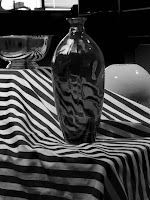
Seeing is at the heart of the interactive process of drawing. We perceive external reality, such as reflective objects sitting on stripped material, with our eyes open. With our eyes closed, the mind searches the images of our inner reality. Our inner reality stores memories of past experiences, interactions, loves, fears, and feelings. In addition, it is here, our inner reality, where we imagine the future. Our drawings comes out of these two forms of vision, one external and one internal.
A drawing of reflective objects sitting on stripped material can communicate our thoughts and perceptions as well as our awareness of the world. The information your eyes send to your brain, such as a silver bowl sitting on black and white fabric, begins an active search by your brain and the mind's eye for structure and meaning. But often those features are neglected because of the tendency to draw what we think we know rather than what we see. We limit our perceptions of the world by abbreviating. Black and white parallel stripes are just that, so we don't have to look to draw them. However, that is the case only when the stripes are two dimensional, when they are parallel to us. If we're going for an illusion in our work, an illusion of a three-dimensional reality on a two-dimensional surface, and if we are going for a drawing that will engage a viewer's eye and imagination, we have to see those stripes as undulating from thick to thin, from one value to the next to the next to the next. We have to see how they change direction from parallel or diagonal to perpendicular. We have to see how they interact with other forms and reflect that reality in such a way that the relationships between the two become apparent and essential to the illusion. It is a communication between your physical eye and your brain, between your brain and your hand, and all of that communication is being sifted through your mind's eye and all of those experiences that inform your work and imbue it with meaning particular to you, the individual who created the drawing. Let's look harder.

I'm really glad that we'll have tomorrow to work on these too. As you were talking and saying things I could see many things I was off on but had simply run out of time on correcting them. I was off on the height of my bottle in proportion to the bowl at first and as I asked in class, my bottle is kind of floating there. So, although I can see improvement on drawing fabric since I started last semester I was still 'off'.
ReplyDeleteIm glad we get tmw to work on it too I hate working with graphite but have never really tried to draw realistically until today...
ReplyDeleteI have a hard time getting really dark values with graphite. I know others seem to be able to do it because I've seen them, but, I haven't mastered that skill yet.
ReplyDeleteSometimes graphite will almost saturate the paper when an area has been worked on quite a bit. That area will become slick and shiny smooth. Once the paper is full it becomes hard to make darker or even erase sometimes. I switch my pencil hardness several times during a drawing. I might even use a really dark soft pencil very early on to make sure my darkest areas get some nice black graphite worked into the paper. Also, make sure you try not to press too hard. I know I have a tendency to press harder to make a darker line which is not wise early on. It seems like every brand of graphite also has its own peculiarities and they change with the type of paper used. Experiment and practice different combinations in sketchbooks and on scraps of paper. I even have some notes and reminders about what materials I used scribbled in sketchbooks. It's 90 percent practice so keep drawing.
ReplyDeleteVery helpful shawn. While my drawing was hanging up beside everyone's in class I noticed my darks were not as dark as I had thought and wondered how others accomplished it so well. I will keep your helpful hints in mind..
ReplyDeleteI saved that tip Shawn. I think I'm going to start a page of notes on things like this in my sketchbook too. That way I'll always have them referenced and handy. Thank you!
ReplyDeleteI find that graphite is very hard to use. I like to have more freedom with my media and I feel very restricted with graphite.
ReplyDeleteinteresting reflections on theory and thought processes behind drawing. The division of what we see and what we think we see. we draw what we know. we can only further our knowledge (at least in the visual realm) through observation. we see something, we draw it, and we begin to understand it better. the next time we see it and draw it, the result will become more accurate. You can't just draw what you see, because you see only a fraction of what is in front of you. Your brain can only process 5% of the information that the eye receives at any given moment. So you extend your visual vocabulary through observation and study of the formal elements.
ReplyDeletevery insightful and thought provoking post! i would like to see what happens when a person draws the same composition multiple times.